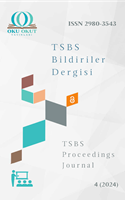İşârî Yorumun Erken Dönemi: Hakîm et-Tirmizî’nin Beyânü’l-fark’ı Üzerine Bir İnceleme
The Early Period of Ishārī Interpretation: A Review on al-Hakīm al-Tirmidhī’s Bayān al-farq
Author(s): Nuriye İnciSubject(s): Middle-East Philosophy, History of Islam, Sociology of Religion, History of Religion, Qur’anic studies
Published by: Oku Okut Yayınları
Keywords: Sufism; al-Hakīm al-Tirmidhī; Bayān al-Fark; Qalb; Ishārī Tafsir;
Summary/Abstract: Hakīm al-Tirmidhī (d. 320/930) was an important Sufi who wrote works in various religious sciences such as hadith and theology, especially Sufism. One of al-Tirmidhī’s important works that contributed to the formation of early Sufism is Bayān al-Farq. Al-Tirmidhī wrote this work within the framework of the question ‘How should the Qur’ān be understood?’, which was one of the basic questions discussed in the formation process of Sufism. The author made an important step in the development of Sufism by quoting verses from the Qur’ān and associating the means of perception, which he explained on the axis of the concept of ‘kalb’, with the interpretive interpretation. In this article, his work is analysed within the framework of the question of what al-Tirmidhī wanted to justify with the connection he established between the levels of perception and al-Ishārī interpretation, and al-Tirmidhī’s theoretical approaches to the subject are evaluated. The study, which was conducted using the content analysis method, focused on the idea that the place of sign and wisdom is the ‘kalb’. In his work built on the concept of kalb, al-Tirmidhī explains the overlooked meanings of the word as ‘sadr, kalb, fuād, and lub’ and states that each degree of perception represents a different level of religious consciousness. He associates the concepts of ‘Islam, iman, marifah and tawhid’ with these centres of perception and names those who represent them as ‘Muslim, mu’min, arif and muwahhid’. The main purpose of this study is to ground the idea that one can comprehend the literal and supererogatory meanings of the Qur’ānic verses according to one’s level of perception and action, and to prepare the ground for the ıshārī interpretation. As a result of the study, alTirmidhī’s Bayān al-Farq is an important work that provides the earliest theoretical infrastructure for the literal and supererogatory interpretation of the Qur’ān in the development process of Sufi thought. Tirmidhī states that continuity in worship and behaviour plays a role in increasing perception and that a person who reaches perfection in his spiritual life increases his potential to understand the Qur’ān. Defining the concept of al-Ishārī as explaining with symbols and presenting subtle signs in accordance with the tawhid of the Truth, al-Tirmidhī refers to jurisprudence with ıshārī interpretation, and to Sufism and the bestowal dimension of religion with al-Ishārī interpretation. The kalb is the centre of al-isārī interpretation; therefore, purification of the kalb and purification of the soul are necessary for the birth of marīfah and wisdom. Al-Tirmidhī builds his theory of the soul and guardianship on this view. In this context, al-Tirmidhī made significant contributions to the grounding of Sufism among religious sciences and the development of its terminology, and also contributed significantly to the understanding of the human imagination with the knowledge of the period.
Journal: TSBS Bildiriler Dergisi
- Issue Year: 2024
- Issue No: 4
- Page Range: 235-252
- Page Count: 18
- Language: Turkish

